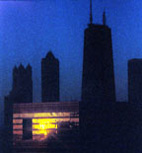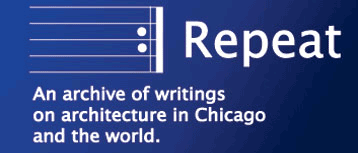

  |
||||
|
|
Chicago's
Battle of the Guides -by Lynn Becker Louis Sullivan or George Elmslie, postmodern or or big blob - you can't tell the buildings or the players without a scorecard. Three new guides to Chicago architecture provide an updated inventory of the city's rich legacy. (originally published in slightly different form under the title "Sites of the City" in the Chicago Reader, May 21, 2004) |
Related Links |
||
|
After a long slumber, architecture in Chicago is again commanding a lot of attention. The current issue of the trade journal Architectural Record is dedicated to the city's revival, with nods to Soldier Field, Millennium Park, Koolhaas and Jahn at the new IIT campus, and Ralph Johnson's Skybridge, plus an overview of rising younger architects such as Jeanne Gang, Doug Garofalo, Darryl Crosby, and Melinda Palmore. This weekend the sixth annual Great Chicago Places and Spaces offers more than 170 architectural tours. And next month the American Institute of Architects will hold its yearly convention in Chicago for the first time in over a decade. To stay on top
of the action, a good guidebook is a must, and Chicagoans Chicago's Famous Buildings was first published in 1965 by the newly created Chicago Landmark Commission as a guide to the city's first 39 official landmark buildings and other notable structures. (That 20 of them have since been demolished shows how anemic the spirit of conservation still was at the time.) The fifth edition came out last fall and is more than a hundred pages longer than the original. The AIA Guide to Chicago, edited by Alice Sinkevitch, was first published in 1993-the last year the AIA held its convention here-and it's been specially revamped for the return of the conference June 12th through the 14th.
CFB's is more democratic in spirit, including essays on such cherished, if architecturally unorthodox, landmarks such as the Loop L and the Chicago Theater. Since the book is pitched to a general audience, you'd expect the prose to be scrappy and evocative - a fun read. Instead, it's a bit of chore, dry as dust, and as impersonal as the instructions for dissecting a frog. Why this should be is a bit of mystery. Franz Schulze is a Chicago icon, author of two lively, indispensable biographies of Mies van der Rohe and Philip Johnson. His co-author Kevin Harrington, professor of humanities and architecture at the Illinois Institute of Technology, gave an engaging informative lecture at the Chicago Architecture Foundation at the time of CFB's publication that traced how perceptions of what qualifies as important architecture have evolved through time. One of his stories related how 1930's architectural students at the Armour Institute - now IIT - looked down their noses at the shiny white terra?cotta facing of the Wrigley Building as "a series of stacked urinals." The original CFB
was subtitled "a photographic guide," including multiple photos,
and even floor plans, of significant buildings like the Rookery and Auditorium.
In more recent editions, that subtitle Compare the books
respective essays on the Carl
Schurz High School at Milwaukee Avenue and Addison. CFB tells
us that the building was designed by Dwight Perkins, uses colorful materials
and "interlocking forms" (twice in an essay of fewer than 150
words), and incorporates influences from "Northern Europe" (not
defined.) The AIA Guide's essay, admittedly three times as long,
includes most of the same details, but brings the building to life with
the story of There's no question the AIA Guide can seem a bit overwhelming. "Too many buildings!" was the reaction of a Seattle architect visiting the city last month, and that's a typical first take. But for an architecture junkie, consulting the AIA Guide is like being handed to keys to the candy store. You can walk down a Loop street and find information on just about every distinctive building you pass. AIA's prose is also lively enough to encourage sustained reading. Perry R. Duis's introduction provides a great overview of the history of Chicago and its architecture in just 20 pages, and Jack Hartray's critique of the concrete gulag that is River North is right on the mark. CFB is divided into three sections-one for the city center, one for the neighborhoods, and one for the suburbs-and contains ten maps. The AIA Guide is divided into seven geographic sections, with 20 neighborhood subections, and 34 maps, including ones that pinpoint where the famous bodies are buried in Graceland, Rosehill, and Oak Woods cemeteries. At $14, CFB
is the economical choice: the AIA Guide costs $30. And even if it's a drag to read, each entry in CFB has its own photograph.
The AIA Guide covers far more entries, but less than a third include photos
© Copyright 2004 Lynn Becker All rights reserved.
|
||||